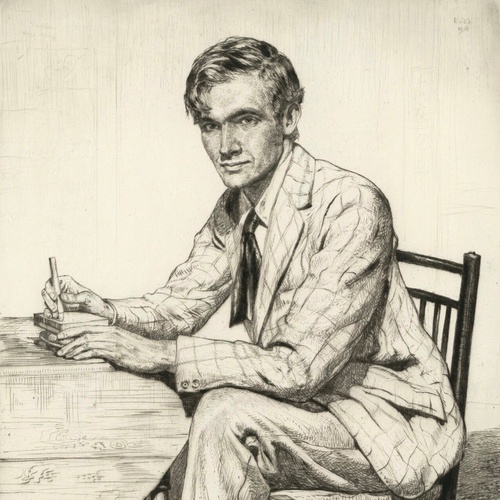Stephen Bone was a 20th century landscape, mural and portrait painter.
He was born in London, the son of the artist and etcher Sir Muirhead Bone. The family lived in Italy between 1910 and 1912, before Stephen returned to attend Bedales School. He went on to study at the Slade School of Art, which now forms part of University College London, from 1922 to 1924 under Henry Tonks. Bone won a gold medal for wood engraving in the Paris International Exhibition the year after his graduation. The rest of 1925 was spent touring Spain with his father and travelling to France, Greece and Scandinavia. In 1929 he married his fellow artist, Mary Adshead, who had been a student with him at the Slade. In the early years of their marriage, the two travelled around Greece, Italy and the British Isles together.
An exhibition of Bone's work, alongside works from Robin Guthrie and Rodney Burn, was held at the London Goupil Gallery in 1926. In 1932 Bone became a member of the New English Art Club, having exhibited with them since around 1920. During the 1930s, he exhibited landscapes and portraits at the Royal Academy, the Fine Art Society, the Lefevre Gallery, and the Redfern Gallery, including a solo exhibition in 1938. An exhibition at Ryman's Galleries, Oxford, in 1936 included oil paintings of forty-one British counties that Bone had created during his travels. During his time in Stockholm in 1936-37, Bone produced many works and had a number of exhibitions.
Though Bone is most recognised for his landscape paintings, he was also an illustrator, portraitist and mural painter. In 1925 his woodcuts illustrated the book 'Of the Western Isles' by Lady Gertrude Bone, his mother. He painted a decorative mural for Piccadilly Circus Underground Station in 1928, though this was sadly replaced by later advertisements. In 1939 he published 'Albion: An Artist's Britain', illustrated with his landscapes. He was also appointed to the committee of the Artists' International Association from 1936 to 1939, where Bone helped artist-refugees from Germany to establish themselves in Britain. During the Second World War, he served as a civilian camouflage officer between 1939 and 1943, before being appointed an Official War Artist for the Navy until the end of the conflict.
After the War, Bone focused on wider culture. In 1946, he published "British Weather" as part of Collins' 'Britain in Pictures' series. Then, from 1948, he took on the role of art critic for the Manchester Guardian, before emerging as a broadcaster in the 1950s. He was to frequently serve on the panel of the BBC radio programmes 'The Critics' and 'The Brains Trust', and on the long-running popular television programme 'Animal, Vegetable and Mineral'. Bone also regularly contributed to the Yorkshire Post and the Glasgow Herald, as 'Luggage McLuggage', author of humorous travel articles.
Aside from broadcasting, in the late 1950s, Bone and his wife organised a mural painting course at Dartington. The two also published several children's books, including 'The Silly Snail', 'The Little Boy and His House' and 'The Little Boy and his Boat', written by Bone and illustrated in collaboration with Adshead. Bone was also chosen as the author of the 'Shell Guide to the West Coast of Scotland'. In 1957 he was appointed the Director of the progressive Hornsey College of Art, but the appointment was cut short by his early death the following year in London.
